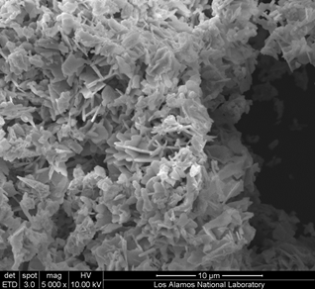The Countering Weapons of Mass Destruction (CWMD) Office was established in December 2017 by consolidating primarily the Domestic Nuclear Detection Office, a majority of the Office of Health Affairs, as well as other DHS elements.
For current information related to CWMD, please visit the following:
The Domestic Nuclear Detection Office’s Exploratory Research (ER) program explores innovative, high risk, early stage applied research that will provide new capabilities to help counter the threat of nuclear terrorism. Research may focus on a specific technological “gap” in detection capabilities, investigate the improvement of existing capabilities, or support improvement in nuclear technical forensics capabilities.
Efforts are intended to result in either a proof-of-feasibility or proof-of-concept demonstration in a laboratory setting that inform whether the concept should abandoned, matured through additional exploratory research or transitioned to an advanced technology demonstration or to direct commercial development. Since inception, the ER program has sponsored approximately 200 research efforts.
Areas for Emphasis
The Program seeks to address the following technical Grand Challenges:
| Grand Challenge | Description |
|---|---|
| Cost Effective | Cost-effective equipment with sufficient performance to ensure widespread deployment |
| Wide Area Monitoring and Search | Enhanced wide-area monitoring and search in a variety of scenarios, to include urban and highly cluttered environments; |
| Shielded Threat Detection | Detection of special nuclear material even when heavily shielded |
| Challenging Pathways | Monitoring along challenging GNDA pathways, to include scanning of general aviation and small maritime vessels, and in between ports of entry, |
| Nuclear Forensics | Linking nuclear forensics signatures of interdicted material to specific processing history and origin through characterization and predictive modeling. |
Each Challenge is addressed by transformational approaches by the following research activities.
| Cost Effective. Research that seeks to enhance the performance and production methods of radiation detection materials and supporting components, in order to achieve the vision of cheaper, easier-to-use and better detectors. | Figure 1: Large Thallium Bromide (TlBr) semiconductor radiation detectors
|
| Wide Area Monitoring and Search. Research advancing radiation detection system performance through novel system designs, use of ancillary contextual information (e.g., video, LIDaR, etc) and advanced analytics. | Figure 2 Urban radiation background mapping reduces nuisance alarms and enhances detection
|
| Shielded Threat Detection. Research in advanced materials and sources for radiographic systems that improve detection of high atomic number materials in cargo radiographic images, and detection of nuclear materials in active interrogation systems | Figure 3 New ability to scan trains for shielded threats at full speed
|
| Pathways. Research in ancillary signatures that may be relevant to or indicative of radiological or nuclear smuggling. Use knowledge and data of traffic, pattern of life, and potential adversary transit to understand encounter dynamics across specific challenging pathways. | Figure 4 New approaches of domain awareness for R/N trafficking
|
| Nuclear Forensics. Research into the chemical, morphological, and radiological characteristics of forensics samples, and modeling and simulation of the processes that produce them. | Figure 5 Uranium Oxide samples aged 2.5 years in a low temperature. 
|
Solicitations
Vendors are solicited annually through Broad Agency Announcements (BAA) and Call for Proposals (CFP). The following entities are eligible for participation:
- BAA – Industry (include small businesses and non-U.S. businesses) and academic institutions
- CFP – National and government laboratories and other federally-funded research development centers
Each solicitation comprise of a white paper and full proposal phase. Prior to the full proposal phase, Offerors will receive notification on their submitted white paper for an invitation to submit a full proposal. However, the Offeror may submit a full proposal without a white paper submission.
Proposal Evaluation
Under each Solicitation, all white papers and full proposals are subjected to a technical evaluation process based on criteria identified in the solicitation and conducted by DNDO subject matter experts. Typically, the ER program issues an annual solicitation beginning in the early fall timeframe, with projected awards in late spring of the following year.
Additional information
- Federal Business Opportunities are available at www.fbo.gov.
- For general inquiries, please contact dndoerp@hq.dhs.gov.
- For ongoing activities under the ER program, please see the ER Fact Sheet.
